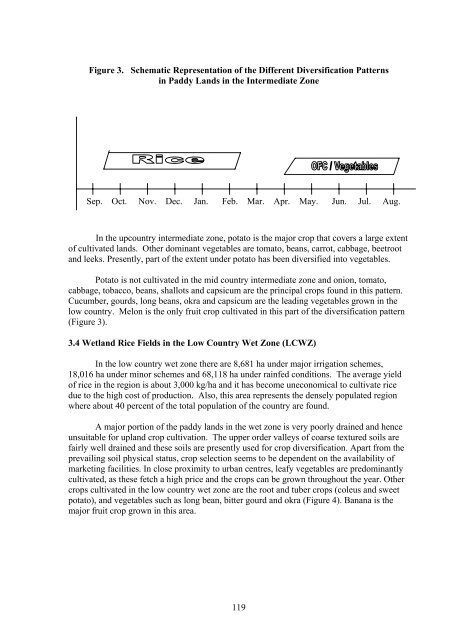Crop Diversification in the Asia-Pacific region - United Nations in ...
Crop Diversification in the Asia-Pacific region - United Nations in ...
Crop Diversification in the Asia-Pacific region - United Nations in ...
- No tags were found...
You also want an ePaper? Increase the reach of your titles
YUMPU automatically turns print PDFs into web optimized ePapers that Google loves.
Figure 3. Schematic Representation of <strong>the</strong> Different <strong>Diversification</strong> Patterns<strong>in</strong> Paddy Lands <strong>in</strong> <strong>the</strong> Intermediate ZoneSep. Oct. Nov. Dec. Jan. Feb. Mar. Apr. May. Jun. Jul. Aug.In <strong>the</strong> upcountry <strong>in</strong>termediate zone, potato is <strong>the</strong> major crop that covers a large extentof cultivated lands. O<strong>the</strong>r dom<strong>in</strong>ant vegetables are tomato, beans, carrot, cabbage, beetrootand leeks. Presently, part of <strong>the</strong> extent under potato has been diversified <strong>in</strong>to vegetables.Potato is not cultivated <strong>in</strong> <strong>the</strong> mid country <strong>in</strong>termediate zone and onion, tomato,cabbage, tobacco, beans, shallots and capsicum are <strong>the</strong> pr<strong>in</strong>cipal crops found <strong>in</strong> this pattern.Cucumber, gourds, long beans, okra and capsicum are <strong>the</strong> lead<strong>in</strong>g vegetables grown <strong>in</strong> <strong>the</strong>low country. Melon is <strong>the</strong> only fruit crop cultivated <strong>in</strong> this part of <strong>the</strong> diversification pattern(Figure 3).3.4 Wetland Rice Fields <strong>in</strong> <strong>the</strong> Low Country Wet Zone (LCWZ)In <strong>the</strong> low country wet zone <strong>the</strong>re are 8,681 ha under major irrigation schemes,18,016 ha under m<strong>in</strong>or schemes and 68,118 ha under ra<strong>in</strong>fed conditions. The average yieldof rice <strong>in</strong> <strong>the</strong> <strong>region</strong> is about 3,000 kg/ha and it has become uneconomical to cultivate ricedue to <strong>the</strong> high cost of production. Also, this area represents <strong>the</strong> densely populated <strong>region</strong>where about 40 percent of <strong>the</strong> total population of <strong>the</strong> country are found.A major portion of <strong>the</strong> paddy lands <strong>in</strong> <strong>the</strong> wet zone is very poorly dra<strong>in</strong>ed and henceunsuitable for upland crop cultivation. The upper order valleys of coarse textured soils arefairly well dra<strong>in</strong>ed and <strong>the</strong>se soils are presently used for crop diversification. Apart from <strong>the</strong>prevail<strong>in</strong>g soil physical status, crop selection seems to be dependent on <strong>the</strong> availability ofmarket<strong>in</strong>g facilities. In close proximity to urban centres, leafy vegetables are predom<strong>in</strong>antlycultivated, as <strong>the</strong>se fetch a high price and <strong>the</strong> crops can be grown throughout <strong>the</strong> year. O<strong>the</strong>rcrops cultivated <strong>in</strong> <strong>the</strong> low country wet zone are <strong>the</strong> root and tuber crops (coleus and sweetpotato), and vegetables such as long bean, bitter gourd and okra (Figure 4). Banana is <strong>the</strong>major fruit crop grown <strong>in</strong> this area.119
















